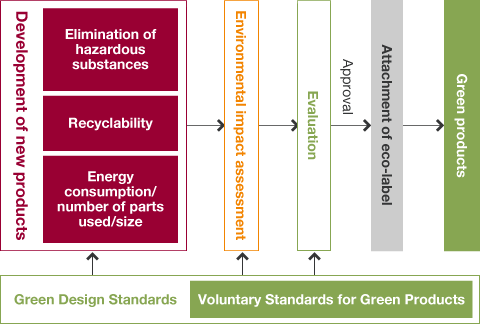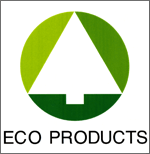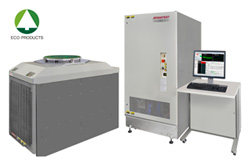 Web Content Display
Web Content Display

Basic stance
Contributing to the sustainable development of society and conducting environmentally-friendly business operations are essential issues that need to be addressed in modern business management. The Advantest Group works to develop products from the perspective of environmental conservation while prioritizing high precision and high quality, and certifies products that are environmentally-friendly in terms of the three key aspects of energy saving and resource conservation, improving recyclability, and elimination of hazardous substances, as green products. There is demand in society for the supply of green products because they provide both a reduction in the environmental footprint as well as an improvement in economic value. The Advantest Group is developing green products in response to these demands and based on the belief that these products will be beneficial for its customers.
Development flow of green products
At the Advantest Group, all new products undergo a product environmental assessment.
During the product environmental assessment, products are assessed from various aspects, including energy savings, the number of parts used, product size, recyclable design, and elimination of hazardous substances. Products that meet the Voluntary Standards for Green Products defined by Advantest are certified as green products and are awarded with an Eco Label (type II).
Development flow of green products

Advantest Group Eco Label
The Advantest Group Eco Label features an original three-color design representing energy and resource conservation, recyclable design, and elimination of hazardous substances through green procurement.
Energy and Resource Conservation
Voluntary Standards
- Energy-saving design
- Reduced-material design
- Miniaturized design
Recyclable Design
Voluntary Standards
- Design with renewable resin materials
- Design for ease of disassembly
- Release of information on disposal

Elimination of Hazardous Substances
(Green Procurement)
Voluntary Standards
- Improved rates of green procurement
- Elimination of banned substances
Energy and resource conservation
We aim to reduce the environmental footprint of our products through product designs that offer energy efficiency, feature ecologically-sound components and materials, and result in units that are smaller in size.
Recyclable design
In recyclable design, we release information on parts that will require special attention during disposal, and we seek to use recyclable materials for resin parts designed in-house. Moreover, we make sure that products are easy to dismantle with standard tools, and we use rechargeable batteries displaying a recycling symbol.
Elimination of hazardous substances (green procurement)
To eliminate hazardous substances from our products, we have established Group standards on banned substances based on the IEC 62474 standard, and we conduct surveys of hazardous substances contained in parts and materials used in our products.
Green products certified during fiscal 2014
We supplied the following products, which were certified as "green products" in fiscal 2014.
- T5503HS
- T6391
- M4871
- TAS7500TS
- T2000 ISS LSMF + IS13TH
- R4751
- R4763
- R3861
- TAS5500
- TS9000
| New Product model | Versus previous product | Energy efficiency improvement (%) | Reduction in components rate (%) | Reduction in size rate (%) |
|---|---|---|---|---|
| T5503HS | T5503 | 68 | 62 | 62 |
| T6391 | T6373 | 49 | 69 | 53 |
| M4871 | M4841 | 67 | 10 | 17 |
| TAS7500TS | TAS7500SP | 90 | 88 | 92 |
| T2000 ISS LSMF + IS13TH | None | No data on reduction rate since there is no previous model to compare against for this new product. | ||
| R4751 | ||||
| R4763 | ||||
| R3861 | ||||
| TAS5500 | ||||
| TS9000 | ||||
Note) The above reduction rate is the value resulting from the performance conversion.
Introduction to green products
The display driver IC test system "T6391"

The display driver IC tester T63xx series is an industry standard tester with installed bases of more than 1,500 systems worldwide. The T6373, released in 2008, was able to meet the market demand for large TV displays for full high-definition, which were leading the market at that time.
However, in recent years the main market for display driver ICs has shifted to smartphones, and it has made rapid developments, such as increasing the number of pins and adding compatibility for touch panels. There are also some features which cannot be measured sufficiently with the T6373, and a new tester that could cover all of functionality was required.
Therefore, Advantest developed the T6391 test system capable of efficiently measuring display driver ICs for smartphones, which was released to the market in December 2014. In addition to increasing the number of pins and compatibility for touch panels, it has a high-speed interface compatible with large TV display driver ICs for new standards such as 4K2K, and also has an easy mechanism for measurement of built-in memory.
Compared to the T6373, in the case of measuring display driver ICs of the latest smartphones, it enables power reduction of 49% in the performance ratio, and contributes to power saving in mass production.



